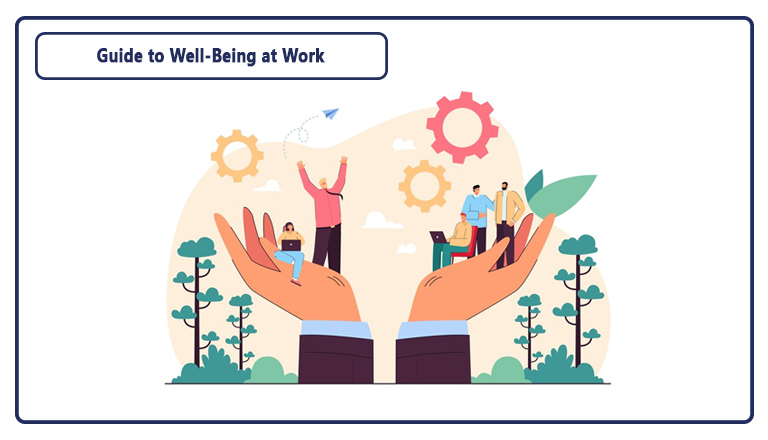While employee health and safety programs have been conducted in organizations for as long as one can remember, ‘well-being’ programs are new to the show. By 2016, The Global Wellness Institute reported that 52% of organizations in North America and 23% of organizations in Europe were starting to have well-being programs in place. Today, 87% of employees consider health and wellness offerings when choosing an employer, and even some governments worldwide, such as the UAEian government, are pioneering having national well-being and happiness agendas.
But what exactly is well-being? And how can it be achieved at work?
In this blog post, we’ll explore what well-being is, why it’s important, and what organizations can do to guarantee creating work environments that support employee well-being.
What is Well-Being?
According to Psychology Today, well-being is ‘the experience of health, happiness, and prosperity. It includes having good mental health, high life satisfaction, a sense of meaning or purpose, and the ability to manage stress.’ Well-being is vital because it is a measure of people’s quality of life. People who have high well-being simply enjoy life more.
Since well-being is centered around how people perceive their lives, it is crucial to realize the subjectivity of the experience. In other words, people attribute their well-being or lack thereof to different factors, depending on what they consider of intrinsic value to them. This means that there is no one-sure-way to well-being nor any one-size-fits-all solution.

The Elements of Well-Being
Well-being is the combination of a mix of feeling good and functioning well. This is because it is the composite result of four different aspects of health: physical, mental, emotional, and social health. Traditional organizational health and safety programs were focused on the physical aspect of well-being, to the detriment of the other factors.
Organizations and employees today know better. This can be attributed to many factors such as the mental health awareness resulting from the 2020 pandemic, the demographic shifts of more millennials in executive roles and more Gen Z joining the labor force, and the global focus on sustainable development rather than the myopic focus on economic development.
The Current Status of Well-Being
With this in mind, what is the status of employee well-being in the workplace today? In the Middle East and the world?
Research by Deloitte that covered 2,100 employees and C-level executives across four countries, the United States, United Kingdom, Canada, and Australia shows disappointing results but increased awareness. According to this research, around one out of three employees and executives struggle with some form of fatigue or poor mental health. On the flip side, however, the tides are changing and increased awareness about the importance of well-being is leading the way. In fact, 68% of employees and 81% of the C-suite say that improving their well-being is more important than advancing their careers.
The results are not significantly different in the Middle East either. Research by McKinsey that covered four Middle Eastern GCC countries— Kuwait, the United Arab Emirates (UAE), the Kingdom of Saudi Arabia, and Qatar— shows that one in three GCC employees report burnout symptoms.
Why Well-Being Matters?
Organizations may wonder what should make them responsible for protecting and promoting their employees’ well-being. Well, the answer is simple! Employee well-being affects almost every aspect of organizational performance that organizations care about.
1. Increased Employee Retention
Globally, employees reporting high levels of toxic behavior at work are more likely to experience burnout, leading to an increased intention to quit. When organizations focus on creating work environments that promote employee well-being, including their psychological health, they benefit from increased employee loyalty and less talent shortage.
2. Increased Employee Productivity
Research by the International Labor Organization (ILO) shows that there is a considerable link between well-being and productivity. ‘The “happy worker” hypothesis provides evidence that higher levels of job satisfaction promote productivity. On the other hand, if well-being in the workplace or in general is low as a result of high levels of stress, productivity may be negatively affected.’
3. Increased Organizational Competitiveness
Happy employees are not only more productive, but also more engaged, creative, and innovative. When employees are highly engaged, this gives their organizations access to their discretionary efforts, which leads to increased performance, affecting product development, revenue generation, and, ultimately, profitability.
What Organizations Can Do to Promote Well-Being
For organizations to thrive today, they should include well-being programs in their cultural agendas. Here is a list of some best practices that can help.
1. Measure your organizational health
You cannot manage what you cannot measure. Organizations like McKinsey provide tools like the Organizational Health Index (OHI) Survey to measure your organizational well-being and benchmark it to other organizations. This kind of measurement tells you what your organizational baseline is and what areas of well-being you need to improve on.
2. Start with a few areas of focus
A common mistake that organizations can make is to jump on the well-being wave with unbridled enthusiasm, which may lead to increased disappointment and frustrations when initiatives fail and can stretch your resources too thin. Instead, after identifying your organizational well-being areas of improvement, choose 1-2 areas of focus, succeed there, and then grow into other areas. Cultural changes take time and resistance is not unlikely.
3. Start change at the top
Regardless of what organization-wide internal communication campaigns say, it is the decisions that executives make every day that, ultimately, impact what priorities managers and employees shall have and how work shall be done. If organizations want to prioritize well-being, executives must create well-being agendas, develop well-being learning strategies, and, most importantly, model positive well-being practices themselves.
4. Make change possible from below
Empower employees by making the organizational conversation around well-being public, encouraging employees to take action against toxic behavior using well-being hotlines, and creating employee well-being resource groups. Moreover, 63% of employees expect you to challenge what is normal by encouraging flexible working hours, introducing 4-day work weeks, and creating no-zoom meeting days, to name a few.
5. Promote transparency around well-being
It has been a tradition for large organizations to announce their annual results to customers, employees, and shareholders. However, for so long, these announcements were limited to financial results, which is commonly known as the single bottom line. Instead, it is better for organizations now to measure and announce their triple bottom line. ‘What is the triple bottom line?’, you may ask. It is a sustainability framework that measures a business’ success in three key areas: profit, people, and the planet. By using the triple bottom line, it would be easier for stakeholders to track if organizations are prioritizing their own employees’ well-being on their path to profitability.
6. Follow a holistic approach to well-being
Remember that well-being is the combination of four aspects of health: physical, mental, emotional, and social health. Therefore, ensure your well-being strategy gives every aspect its due focus. Good hiring and promoting decisions, great teamwork environments, and recognition programs all support the emotional well-being of employees. Investing in health and safety equipment and training protects employees’ physical well-being. Good pay, child care, and healthy leave policies all promote employees’ social health. Flexible work arrangements and opportunities for growth and development support employee mental well-being and help them achieve their full potential. There is no one way of doing things. Well-being is a subjective experience, so it is better to provide a wide variety of programs and give employees the freedom to use what serves their definition of it.
Become a Happier Organization Today
If you’re interested in knowing more about how we can help you with your well-being goals or are interested in viewing a live demo, you can check out our corporate solutions here.


